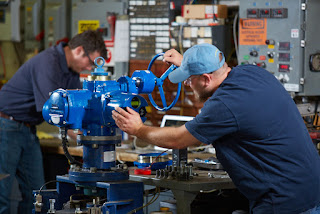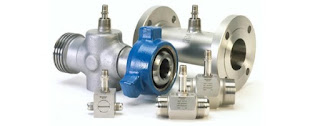
The Swanson Flo Blog is dedicated to provide educational and new product information on process control instrumentation, control valves, and valve automation. For more information on these products, visit SwansonFlo.com or call 800-288-7926.
Swanson Flo Markets - New Video
Here's a new short video highlighting the markets that Swanson Flo serves in the upper midwest United States.
Posted by
Swanson Flo
Labels:
Control,
Illinois,
Indiana,
instrumentation,
Iowa,
Michigan,
Minnesota,
Montana,
Nebraska,
North Dakota,
process automation,
South Dakota,
valve automation,
Wisconsin,
Wyoming
Valve Automation Basics: Electric Actuators
 |
| Electric Actuator Assembly (Limitorque) |
There are other motive forces used for valve actuators, including hydraulic and pneumatic, but electric actuators carry their own particular set of operating characteristics that make them an advantageous choice for many applications.
Valve actuators are available in uncountable variants to suit every application scenario. There are three basic valve actuation motions.
- Multi-turn, with repeated rotations of the valve shaft needed to move the valve trim from fully open to fully closed. A gate valve is a multi-turn valve. These are also called linear, with respect to the motion of the closure element. The term "linear", in this case, refers only to the movement of the valve trim and not the flow characteristics of the valve.
- Part Turn, where a 90 degree rotation of the valve shaft produces a change from opened to closed. Ball valves are in this category.
- Lever, generally associated with damper control.
 |
| Completed Electrically Automated Valve |
There are numerous considerations to take into account when selecting an electric actuator.
- Torque needed to effectively operate the subject valve.
- Actuator enclosure type - wash down, hazardous area, dust, etc.
- Service area for the assembly - corrosive environment, temperature extremes, and more
- Valve movement - linear, multi-turn, part turn, lever
- Operation mode - open and close only, positioning, modulating
- Frequency or duty cycle - infrequent, frequent, or almost continuous positioning
- Communication - How will the local controller communicate with the central control system?
- Electrical - What electric power characteristics are available for operation?
- Protections - Motor overload, torque limit, others
- Process Safety - Among other things, what happens if power fails?
There are certainly other elements to consider when applying an electric actuator for industrial use. Share your valve and actuator requirements and challenges with product specialists, combining your process knowledge with their product application expertise to forge the most effective solutions.
https://swansonflo.com
800-288-7926
Posted by
Swanson Flo
Labels:
electric actuator,
Illinois,
Indiana,
Iowa,
Limitorque,
Michigan,
Minnesota,
Montana,
Nebraska,
North Dakota,
South Dakota,
valve automation,
Wisconsin,
Wyoming
Swanson Flo Performance - Full Capability Instrumentation and Valve Service & Repair
In-house repair as well as field service capabilities for process measurement and control.
Swanson Flo Performance supports every process control customer with region-based, full-capability service and repair. Both in-house and in-field. Built on more than 50 years of applications experience and technical knowledge.- From valves and instruments to actuation, fabrication and preventative maintenance.
- Our technicians are factory-certified.
- Shop is factory audited.
- Total service for process measurement and control
- Valve actuation facilities – the "Center of Excellence"
- Instrument calibration, repair, and trouble-shooting services
Call 800-288-7926 or visit https://swansonflo.com
Posted by
Swanson Flo
Labels:
calibration,
Illinois,
Indiana,
instrumentation,
Iowa,
Michigan,
Minnesota,
Montana,
Nebraska,
North Dakota,
Performance,
repair,
service,
South Dakota,
valve automation,
Wisconsin,
Wyoming
Limitorque MX Actuator Users Instructions, Maintenance, and Spare Parts Manual
The Flowserve Limitorque MX actuator controls the opening and closing travel of valves and other actuated devices. OPEN and CLOSED limits are protected by an absolute encoder that provides optical sensing of valve position and measures valve position in both motor and handwheel operation.
No battery or backup power supply is required. Output torque is derived from motor speed, temperature, and voltage. If the preset torque is exceeded, the motor shuts off. As a result of this reliable and advanced protection technology, all valve and other actuated devices are protected from potential damage from overload, improper seating, and foreign obstructions.
A range of control and network options is available and can be easily added to the control capabilities already available on a standard actuator.
You can download the Limitorque MX Electronic Actuator User Instructions, Maintenance, and Spare Parts Manual in PDF version from the Swanson Flo site here (8.5MB), or read the embedded version below.
No battery or backup power supply is required. Output torque is derived from motor speed, temperature, and voltage. If the preset torque is exceeded, the motor shuts off. As a result of this reliable and advanced protection technology, all valve and other actuated devices are protected from potential damage from overload, improper seating, and foreign obstructions.
A range of control and network options is available and can be easily added to the control capabilities already available on a standard actuator.
You can download the Limitorque MX Electronic Actuator User Instructions, Maintenance, and Spare Parts Manual in PDF version from the Swanson Flo site here (8.5MB), or read the embedded version below.
Posted by
Swanson Flo
Labels:
electric actuator,
Flowserve,
Illinois,
Indiana,
Iowa,
Limitorque,
Michigan,
Minnesota,
Montana,
Nebraska,
North Dakota,
South Dakota,
valve automation,
Wisconsin,
Wyoming
Turbine Flow Meters
 |
| Turbine flow meters (Badger Meter / Blancett) |
Turbine flow meters use the mechanical energy of the fluid to rotate a turbine blade in the flow stream and provide precise and accurate flow measurement. The flow impinging upon the turbine blades causes the rotor to spin. The angular velocity of a turbine flow meter is proportional to flow rate. The rotational velocity of the turbine is interpreted as an electrical frequency output through the use of magnetic pick-ups. As each turbine blade passes by the magnetic pick-up coil, a voltage pulse is generated which is a measure of the flow rate. The total number of pulses gives a measure of the total flow which can be totalized with a maximum error of a single pulse.
The relationship of the angle of the turbine meter blades to the flow stream governs the angular velocity and the output frequency of the meter. The sharper the angle of the turbine blade, the higher the frequency output.
Easy to maintain while also boasting reliability, turbine flow meters are known to be cost-effective solutions that make an ideal device for measuring flow rate. Aside from excellent rangeability, they also provide high response rate and high accuracy compared to other available types of flow meters. Turbine flow meters are sturdy, need very little maintenance, and seldom exhibit much deviation in performance.
 |
| Turbine flow meters (Hoffer Flow Controls) |
Advantages:
- Accuracy
- Excellent repeatability and range
- External power not required
- Good fro cryogenic applications
- Good for extreme pressures and temperatures
- Easy to install
- Material availability
- Not recommended for contaminated media or slurries
- Error due to wear
Posted by
Swanson Flo
Labels:
Badger,
Blancett,
flow control,
Hoffer,
Illinois,
Indiana,
Iowa,
Michigan,
Minnesota,
Montana,
Nebraska,
North Dakota,
South Dakota,
turbine flow meter,
Wisconsin,
Wyoming
Disassembly, Repair, and Rebuild of the Jordan Mark 78 Control Valve
The Jordan Mark 78 pneumatic control valve is designed for accurate performance and simplified maintenance. This versatile product can be used on a variety of applications, including viscous/corrosive liquids, process gases or steam in process or utility service.
- Shutoff: ANSI Class IV or VI
- Sizes: 1/2" – 2" (DN15 – DN50)
- End Connections: Threaded, Flanged, Socket Weld, Butt-Weld
- Body Materials: Bronze, Carbon Steel, Stainless Steel
- Cv (Kv): up to 50 (up to 43)
- Trim Materials: Stainless Steel, Monel, Hastelloy C, Alloy 20
- Seat: ANSI Class IV (Hard Seat); ANSI Class VI Teflon (Soft Seat)
- Control Ranges: 3-15 psi, 6-30 psi or split ranges (0,2-1,0 bar, 0,4-2,1 bar)
The video below provides a detailed demonstration of how to disassemble, repair, and rebuild the Mark 78 control valve.
800-288-7926
Posted by
Swanson Flo
Labels:
Control Valve,
Illinois,
Indiana,
Iowa,
Jordan,
Mark 78,
Michigan,
Minnesota,
Montana,
Nebraska,
North Dakota,
South Dakota,
Wisconsin,
Wyoming
Understanding Explosion Proof Enclosures Used in Process Control
This is a short video that explains what an explosion-proof enclosure is, what defines it as “explosion-proof”, and the principle behind why its safe to use in explosive or combustible atmospheres.
“Explosion-proof" doesn't mean the enclosure can withstand the forces of an external explosion. It means that the enclosure is designed to cool any escaping hot gases (caused by an internal ignition) sufficiently enough as to prevent the ignition of combustible gases or dusts in the surrounding area.
https://swansonflo.com
800-288-7926
“Explosion-proof" doesn't mean the enclosure can withstand the forces of an external explosion. It means that the enclosure is designed to cool any escaping hot gases (caused by an internal ignition) sufficiently enough as to prevent the ignition of combustible gases or dusts in the surrounding area.
https://swansonflo.com
800-288-7926
Posted by
Swanson Flo
Labels:
Illinois,
Indiana,
Iowa,
Michigan,
Minnesota,
Montana,
Nebraska,
North Dakota,
process control,
South Dakota,
what does explosion proof mean,
Wisconsin,
Wyoming
Subscribe to:
Posts (Atom)


